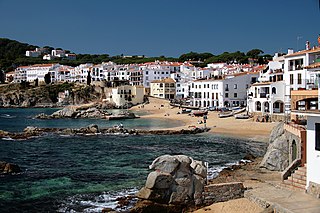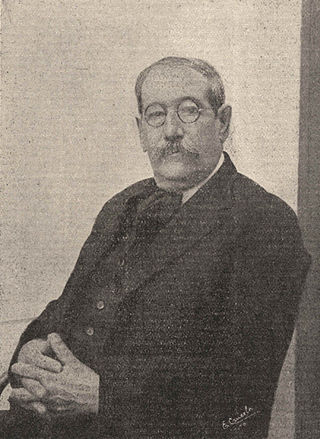
Andean music is a group of styles of music from the Andes region in South America.
The music of Bolivia has a long history. Out of all the Andean countries, Bolivia remains perhaps the most culturally linked to the indigenous peoples.
Los Jairas was a Bolivian folk music group that was active in the 1960s. Their work features the charango, a stringed instrument from Bolivia.

The Costa Brava is a coastal region of Catalonia in northeastern Spain. Sources differ on the exact definition of the Costa Brava. Usually it can be regarded as stretching from the town of Blanes, 60 km (37 mi) northeast of Barcelona, to the French border – in other words it consists of the coast of the province of Girona.
Cumbia villera is a subgenre of cumbia music originating in Argentina in the late 1990s and popularized all over Latin America and Latin communities abroad.
This is a list of folk music traditions, with styles, dances, instruments, and other related topics. The term folk music cannot be easily defined in a precise manner. It is used with widely varying definitions depending on the author, intended audience and context within a work. Similarly, the term traditions in this context does not connote any strictly-defined criteria. Music scholars, journalists, audiences, record industry individuals, politicians, nationalists, and demagogues may often have occasion to address which fields of folk music are distinct traditions based along racial, geographic, linguistic, religious, tribal, or ethnic lines, and all such peoples will likely use different criteria to decide what constitutes a "folk music tradition". This list uses the same general categories used by mainstream, primarily English-language, scholarly sources, as determined by relevant statements of fact and the internal structure of works.

Arenys de Mar is one of the main municipalities of the comarca of Maresme, Barcelona Province, Catalonia, Spain. It is situated on the coast between Caldes d'Estrac and Canet de Mar, about 40 kilometres northeast of Barcelona. As of 2022, it had a population of 16,155.

The Bolivian Palace of Government, better known as Palacio Quemado, was the official residence of the President of Bolivia from 1853 to 2018 and again briefly from 2019 to 2020. It is located in downtown La Paz on Plaza Murillo, next to the La Paz Cathedral and across from the Bolivian legislature. On 9 August 2018, it was replaced by the Casa Grande del Pueblo as the residence of the president by President Evo Morales. The interim government of Jeanine Áñez briefly reverted to occupying the Palacio Quemado from 2019 until 2020 when the newly elected Luis Arce returned to using the Casa Grande. It now serves as a museum.
Khanata, or Grupo Khanata, is a contemporary Bolivian Andean music group.
The Camí de Ronda was a footpath built along the Costa Brava coast to help the Carabineros, and subsequently the Guardia Civil, control the coast and stop smuggling.

A salchipapa or salchipapas is a South American fast food dish commonly consumed as street food, typically consisting of thinly sliced pan-fried beef sausages and French fries, mixed together with a savory coleslaw on the side. The dish's name is a portmanteau of the Spanish words salchicha (sausage) and papa (potato). The dish is served with different sauces, such as ketchup and mustard, crema de aceituna, along with aji or chili peppers. Sometimes a fried egg or cheese is added on top; it can also be served with tomato and lettuce, and is occasionally garnished with oregano.

Calella de Palafrugell is one of three coastal towns belonging to the municipality of Palafrugell in the province of Girona, Spain. The other two towns are Llafranc, only one kilometre (0.62 mi) to the north, and Tamariu, some four kilometres (2.5 mi) to the north. All three towns are part of the Costa Brava, the coastal region of northeastern Catalonia, in the comarca of Baix Empordà. It should not be confused with the larger, more commercialised resort of Calella, which is further south towards Barcelona, in the comarca of Maresme.

José Alonso y Trelles (1857–1924) was a Uruguayan poet who wrote under the pseudonym El Viejo Pancho.

Jarava ichu, commonly known as Peruvian feathergrass, ichhu, paja brava, paja ichu, or simply ichu, is a grass species in the family Poaceae native to the Americas. It is found growing in a vast area: Mexico, Guatemala, Costa Rica, El Salvador, Venezuela, Bolivia, Colombia, Ecuador, Peru, Dominican Republic, Chile, and Argentina. It is a common grass of the Andean altiplano. It is used as fodder for livestock.

The Rough Guide to the Music of the Andes is a world music compilation album originally released in 1996. Part of the World Music Network Rough Guides series, the album features the music of the Andes Mountains of South America, focusing especially on the music of Bolivia, whose musicians contributed eleven tracks. Also featured is Peru and Chile. The compilation was produced by Phil Stanton, co-founder of the World Music Network.
Jorge Roca Suárez, also known as "Techo de Paja", is a Bolivian drug trafficker, best known for being the nephew and successor of notorious drug lord Roberto Suárez Goméz.

The Cathedral Basilica of Our Lady of Peace, also called La Paz Cathedral, is a cathedral and minor basilica is located in Murillo Square in the city of La Paz in Bolivia. It was built in 1835 with a neoclassical architecture with Baroque elements. It has an interior consisting of five naves with different layers.

Copacabana Restaurant, is a restaurant at Seattle's Pike Place Market, in the U.S. state of Washington. The business has been described as "one of the oldest Latino restaurants in Seattle", as well as "one of Pike Place's most offbeat eateries".










